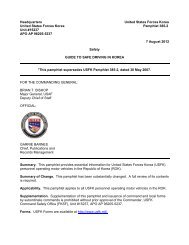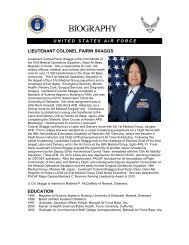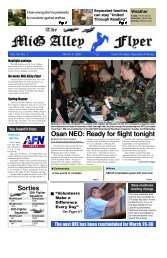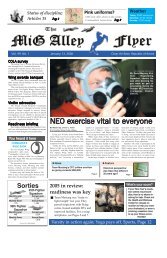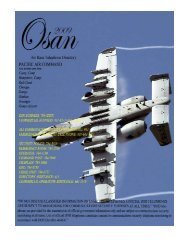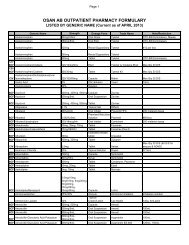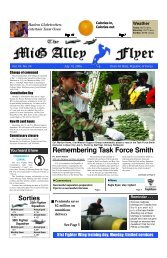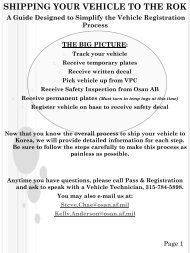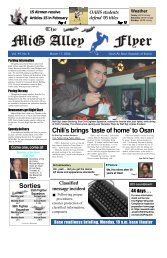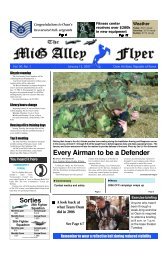July 21_final.qxd - Osan Air Base
July 21_final.qxd - Osan Air Base
July 21_final.qxd - Osan Air Base
You also want an ePaper? Increase the reach of your titles
YUMPU automatically turns print PDFs into web optimized ePapers that Google loves.
4MiGAlley Flyer<strong>July</strong> <strong>21</strong>, 2006NEWSThe myths, the truths and the inedibleBy Master Sgt. Cheryl L. Toner51st Fighter Wing Public AffairsWith a peninsula operational readinessexercise about to kick off and many peoplerelying on meals ready to eat for their sustenance,we decided to perform an informal,non-scientific taste test of selectedMREs.While there are currently 24 differentMREs, we only taste testedseven. We were able,however, to get a mix ofpeople ranging fromKorean civilians whohave never tried an MREbefore, to military peoplewho ate MREs atleast 20 years ago.Our main goal:judge each item on itstaste, texture, smell, look,etc. Also, wanted to knowwhich ones were the best, whatare the truths and myths aboutMREs, a little history, the typesof MREs -- yes, there is morethan one -- and what is the shelflife of an MRE.The good,bad and uglyFirst, The Big Test: Taste. Of the24 available, we tested these sevenentrees: Black bean and rice burrito;chili and macaroni, CountryCaptain chicken with noodles inbutter flavor sauce; pork chop,chunked and formed, in Jamaicanstyle sauce with noodles; beef stew;chicken breast strips with chunky salsa; and,beef ravioli.Of the four, the burrito scored the lowest. Once we gotover the, "Is that it?" regarding its size, we soon discoveredthis would fall under the heading of "nice try, but no." Thebeef stew received the highest marks. Amazingly, thisMRE has endured and, according to a Washington Postarticle, has been a favorite since it was introduced in 1981.Coming in neck-and-neck for the second best was the chilimac and beef ravioli.A toss up in the taste race was the pork chops: peopleeither loved it or hated it. One person said the pork choptasted like it was homemade, while others said it had aLysol/bar of soap aftertaste. When there is a lull in activityduring the exercise, maybe this entrée is one item for yourunit or office PenORE Fear Factor.What’s on the side?Now about the side items. All MREs have some sort ofpacket that contains a beverage -- just add water -- as wellas some type of seasoning, candy, crackers with cheese orpeanut butter, cookies, etc. You get the picture.The peaches and spiced apples were rated the highestfor side items. The Mexican rice, a side to the chickenstrips in salsa, didn't fare so well. The rice seemed hard,but not undercooked, so the texture is puzzling.The worst side item was the noodles in butter flavorsauce. Sliding out of the wrapper in one perfectly formedwhite chunk of noodle, it started out bad. The taste made iteven worse. Maybe the tiny bottle of Tabasco sauce --which is now in 20 of the 24 meals options -- would havehelped. Maybe, but probably not. The other four MREpacks contain either a salt-free seasoning blend or groundred pepper.Worthy of praise was the jalapeno cheese spread. Mostpeople liked it, even though the consistency seemed a littleMREsthick. Areminder: boththe regular and jalapenocheese spread needs to be kneaded before opening the package.The drinks, overall, weren't too popular. We tried acocoa beverage powder, cappuccino mocha, lemon-limebeverage, and a strawberry shake. Most of the drinksearned a "take it or leave it," type of reaction; however,most people didn't like the strawberry shake. One personsaid, "I never cared for Pepto Bismol." However, someoneelse said the vanilla and chocolate versions were better …we think we'll just take his work for it.MythsThe No. 1 myth would be that all MREs taste horrible.Actually, they don't. Maybe it's the psychological fact thatyou're eating something out of a pouch. Interestingly, thechili and macaroni tasted dangerously close to that done bya Mr. Chef Boyardee.The No. 2 myth would be that MREs contain at least3,000 calories. Wrong! An average MRE - one that wenon-special operations military people would eat - containsabout 1,200 calories. There are, however, a number of differenttypes of MREs, ranging in calorie values from about1,000 to 4,500. More about that later in this article.Myth No. 3 is that MREs cause constipation. A coupleof our taste testers said they had a little gastrointestinal disturbancelater that day, but most testers did not. The U.S.Army Research Institute of Environmental Medicine, medicalresearch personnel who advise on adequacy andacceptability of rations, say that is not true. "The fiber contentof field rations, while not high, is adequate to preventconstipation," according to the USARIEM web site."Insuring an adequate fluid intake is of greater importancein the prevention of constipation than the total fiberintake." In layman's terms: drink enough water.A little historyMREs have come a long way in arelatively short amount of time.Prior to 1940, each branch ofthe service was responsiblefor the care and feeding oftheir people. However, in1941, a HooverCommission study recommendedthat theservices centralize perishablefood management,according to theDefense Logistics Agency.By Vietnam, a logistical miracle-- or nightmare, dependingon where you worked -- meantthat around 1966, large portablerefrigerated walk-in storageboxes filled with perishables,such as beef, eggs, and freshfruits and vegetables, startedarriving in Vietnam.Since then, the militaryhas improved its ability toprovide "portable" mealswithout serving food from afield kitchen. From updatingthe menu choices to creatingmore variety, MREs havebecome pretty popular. Theflameless heating device is alsogenius.The shelf lifeDespite popular belief, MREsdon't last for a decade or more. MREslast about three years if stored at 80 degreesand, if stored at lower temperatures, will lastlonger. Also, MREs don't "go bad" like a gallon of milkdoes. The expiration date marks when the quality of theMRE will degrade in taste, nutritional value, quality, etc.;however, MREs can be tested to see if they're still edibleafter the expiration date.TypesMRE: According to the DLA Defense Supply CenterPhiladelphia, the typical MRE provides an average of1,250 calories, about 13 percent protein, 36 percent fat, and51 percent carbohydrates. One MRE also provides aboutone-third of the recommended daily allowances for vitaminsand minerals as determined by the U.S. SurgeonGeneral.Meal, Religious, Kosher/Halal: This one is like an MREbut it is designed for people who maintain a strict religiousdiet. The meal also is about 1,200 calories; however, it hasa shorter shelf life of 10 months.Ration, Cold Weather: The RCW is used to sustain peopleduring operations in arctic conditions, the container iswhite instead of tan, and each ration consists of a full day'sallowance. That puts this kit at 4,500 calories! This ration,according to the DLA, provides enough calories to provideenergy for someone in extreme cold, during heavy exertion,while limiting sodium and protein content to reducethe risk of dehydration.Meal, Cold Weather/Food Packet, Long Range Patrol:This ration is also for extreme cold weather; however, theMeal, Cold Weather, will not freeze and it contains extradrink mixes to counter dehydration. The LRP kit is arestricted calorie ration mean for special operations whereresupply is not available and weight and volume are criticalfactors. The shelf life here is also three years.There are also a few other types, but enough. You getthe idea. Bon appetit!
READY TO FIGHTMiG Alley Flyer<strong>July</strong> <strong>21</strong>, 20065How to cross contaminated zonesAfter an attack, limit travel in and out ofcontaminated zones to prevent cross-contamination.Before going anywhere, know your informationresources, which are the Commander’sAccess Channel, Channel 13, Armed ForcesRadio and your unit control center (UCC). Know what zones are contaminated so youcan adhere to directed MOPP levels while contaminationis present. Keep situational awareness while travelingaround base with the zone map in your<strong>Osan</strong> ATSO guide. Personnel and vehiclespass through chemical zonesvia transition points. Thesetransition points are typicallyroad intersections where potentiallyclean and dirty chemicalzones intersect. You must use the transitionpoints when passing betweenzones. Follow instructions ontransition point signs, using theplastic troughs for hand and bootdecontamination.If you're contaminated and passinginto a clean zone, contact your UCCfor specific guidance. In general:Stay in MOPP 4 while performing missionessentialtasks in the clean zone. You are ineffect a "contaminated asset" and the 10-foot rule applies. Process through a contaminationcontrol area (CCA) whendirected by your UCC. If seeking rest and relief, you mustprocess through a CCA. You may be directedto proceed to a CCA or SurvivableCollective Protective System.Do this by selecting the most direct routeand at the direction of your UCC.Personnel processing will need to be inMOPP 4.Once you suspect contamination on yoursuit (normally by looking at your M9 paper),you must decontaminate yourself, head tofoot, with the M291 or M295 decon kit. Afterdecon, a step-by-step CCA needs to be usedas soon as directed by your UCC.MOPP 2 to MOPP 4instructions1. Ensure M9 is placed on chemical suit2. Don posted MOPP level3. Proceed through transition pointMOPP 4 to MOPP 2instructions1. Check M9 for contaminationUsing a water-bleach solution to decontaminateis required to cross zones.2. If contaminated, decon with M295, rinseboots in bleach and gloves in bleach and water.Remain in MOPP 4 and contact UCC immediately.Maintain MOPP 4 until processedthrough a CCA3. If uncontaminated, assume new zone MOPPLevel4. Proceed through the transition pointSMALL thenbigInjectors are numberedto give you a 1, 2 survival punchSigns of nerve agent exposureMild Symptomsn Difficulty seeingn Unexplained runny nosen Tightness in chestn Sudden drooling or headachen Localized sweating and musculartwitchingn Stomach crampsn NauseaThe ability to survive may dependon recognition of chemical-nerveagents and the immediate injection ofatropine shots from a Mark 1 kit.Indications of M8 or M9 paper arenot enough to warrant inoculationswith the atropine auto-injectors.Several symptoms need to be present.The symptoms range from mild tosevere, but a victim doesn't have toshow all of them before injection.The symptoms should progressquickly but environmental factorscome into play as well.If the area hasn't been hit withchemical weapons or no trace of thoseagents has been reported, personsshowingSevere Symptomsn Muscle twitching and weaknessn Difficulty breathing, wheezingor coughingn Pinpoint pupils, red eyes,tearingn Strange, confused behaviorn Vomiting, urination, defecationn Convulsionsn Respiratory failuren Unconsciousnessn Deathmild symptoms should be masked andmonitored. Only if the symptoms getworse should the injections be administered.Atropine auto-injectors are administeredone after the other, yellow firstthen gray. The injectors are labeled 1and 2 to indicate which goes first. Theinjectors may come in a plastic cliplabeled 1 and 2.To apply, remove safety caps andpress the injector into the thigh muscleuntil the needle engages. Hold the needlein place for 10 seconds. Be sure notto put the thumb over the end whileapplying pressure.Gas masks must be on during injections`and all used needles must beattached to the victims' clothing somedical personnel are aware of administeredmedications.If mild symptoms persist after 10 to15 minutes, a buddy should administera second kit. With severe symptoms, allthree Mark 1 kits must be administeredimmediately. Some symptoms can betreated without atropine shots."Nerve twitching is a telltale symptomthat begins locally," said 51stMedical Operations Squadron officials."If someone has nerve agent poisoning,normally the nerve twitching is in onearea and that area needs to be decontaminated."In order to decontaminate an infectedarea on the skin, M291 or M29Decontamination Kits are availablewith directions.Use the M291 skin decontaminationkit for liquid chemicals.Courtesy photosAtropine auto-injectors are numbered;upper is two, lower is one.Inject atropine in meaty area ofbuttocks or leg.
6MiGAlley Flyer<strong>July</strong> <strong>21</strong>, 2006READY TO FIGHTSplit MOPP levels divide base Zones allowmission to continueDuring the exercise, the 51st FighterWing will implement what is called splitmission oriented protective postures, orsplit MOPPs. This allows the wing commanderto keep personnel in contaminatedzones in MOPP 4 while the remaininguncontaminated zones can go into MOPP2.This minimizes the impact on personnelin uncontaminated areas following achemical or biological attack. Pre-determinedchemical zones and air basedefense sectors are used to quickly andaccurately communicate split MOPP decisions.The wing passes notification of splitMOPP levels via the Commander's AccessChannel, unit control centers, telephoneand radio.Some exercise members may findthemselves in a split MOPP situation andworking in chemical hazard zones after anattack. In this case, some zones mayreduce their MOPP level depending onhazard levels found in the area. If unsure,remain in higher MOPP level until verificationis obtained.When advised that contaminated zonesare safe enough to remove the mask, someareas will require combatants to remain inMOPP 4, with a 10-foot rule in effect.The 10-foot rule applies around all contaminated assetsand has two phases. In the initial phase people who must usethe contaminated asset must be in MOPP 4 when within 10feet. They can reduce their MOPP level when past the 10-footmark but still in a MOPP 2 zone. It's important, for personnelto decontaminate their gloves prior to MOPP reduction if theyNuclear, Biological and Chemical Zone Maptouch contaminated assets.In the follow-on phase, people should continue to handlecontaminated assets with gloves (any type) regardless of theamount of time after the attack once MOPP 4 requirements areterminated.It's crucial for everyone to be aware of their location toensure that they remain in the proper MOPP level.The commander's access channel and the American ForcesNetwork radio will broadcast MOPP conditions and affectedzone information.When moving from the clean area to the dirty area, dressout in MOPP 4 at the transition point.Use SALUTE to report informationabout enemy actionsLike your mother said ...(Left to right), <strong>Air</strong>man Erik Redlinger of the 51st Security Forces Squadron, <strong>Air</strong>man 1st Class Jeffrey Stepp of the51st Communications Squadron, and <strong>Air</strong>man 1st Class Camron Francis of the 51st Security Forces Squadron guardthe 51st Fighter Wing Headquarters building during Exercise Beverly Bulldog 05-02 in <strong>July</strong> 2005. During thePeninsula Combat Employment Readiness Exercise, Exercise Evaluation Team opposing forces will be infiltrating<strong>Osan</strong>. Be sure to use the SALUTE to report all suspicious activity.Use the S-A-L-U-T-E report as a quick and effectiveway to communicate enemy information up thechain of command.Size: The number of personnel/vehicles seen or sizeof an objectActivity: Enemy activity (assaulting, fleeing, observing)Location: Where the enemy was sighted. Use aPhoto by Senior <strong>Air</strong>man Samuel Gilbertgrid coordinate or readily identifiable reference pointUnit/Uniform: Distinctive signs, symbols or identificationon people, vehicle or weapons (numbers, patches or clothingtype)Time: Time the activity was observedEquipment: All equipment/vehicles associated withthe activityBe careful or you’llput an eye out!Obviously this person is“moulaged” from a previousexercise; however,every exercise participantneeds to remember thefirst rule in any action:safety first. Another thing toremember is to never leavehome without the <strong>Air</strong>man’sManual. Lots of good stuff,like how to deal with this“injury,” are in the manual.
8MiGAlley Flyer<strong>July</strong> <strong>21</strong>, 2006READY TO FIGHTContamination markings<strong>Osan</strong> no longer uses three Xs, but now uses inverted triangles or red andyellow “Gas” stickers to identify contaminated equipment. The time and dateof the attack are marked on each sign and contaminated assets should bemarked so they can be seen at least 10 feet away.MCU-2A/PProtective Maskn Must be inspected everyseven days during wartime.n Document the inspectionon a DD Form 1574(Serviceability Tag).n Make sure drinking tubeis clean and free of debris.n After removing the filterand head harness, clean withmild liquid detergent andwarm water.n Do not over tighten the mask,which may actually cause leaks.Bicycle safetyBicyclists will wear MOPP 1 while riding their bicycles duringMOPP Levels 1 and 2, but a bicycle helmet must be worn in placeof the government-issued helmet.The Kevlar helmet and overboots will be carried while riding.When the bicycle is dismounted, the Kevlar helmet must be worn.Upon indication of an Alarm Blue, participants must react by dismountingtheir bicycles, seeking appropriate cover and assumingthe declared MOPP level.Bicyclists won’t ride their bicycles during MOPP Levels 3 and 4.If movement is required during MOPP 3 or 4, individuals willdon the CWDE in accordance with the current MOPP level andwalk their bicycles.Don’t wear any of the following at any time while riding a bicycle:Kevlar helmet, over boots, gas mask.Readiness tips to get through a PENORE10-foot rule Initial Phase Purpose – Protect users of contaminated assets from vaporhazards Action required – When using contaminatedassets, don MOPP 4 Duration – Dependent on weather andagent, in most cases not more than 24 hoursWhen 10-foot rule Phase 1 expires, put asingle line through the inverted triangle. Besure to write the time and date when Phase 1was rescinded.10-foot rule FollowonPhase Purpose – Protectusers of contaminat-edassets fromcontact hazards Action required – Whenusing contaminated assets, be sure touse any type of gloves Duration – Rest of the asset’s lifeM8 chemical detection paper Place on all four sides of building Ensure you place M-8 on flat horizontal surfaces to detectfalling mist or droplets Place M8 paper near the primary entrance/exit Place M8 paper on all vehicles, equipment, around facilities Write date and time on the paper Replace after attack or after rain Do not place tape or plastic on top of the paper Keep paper in area to collect falling chemicalsTwo fingers on the voicemitter Anytime anyone does anything with your mask or hood youneed to place two fingers on your front voicemitter This will prevent the mask’s seal from breakingSpecific times to use two fingers: Drinking from a canteen with mask on Buddy checks CCA processing Putting on the hood or helmet Coughing or sneezingFilling canteens inchemical environmentsAnytime you are drinking from your canteen,try to have a buddy close by to assist. Don’t accomplish tasks when chemicalcloud is still settling (up to one hour afteran attack) Refill in location that provides overheadcover Ensure suit is free of contamination, decontaminateif necessary Decontaminate outer portion of canteen and/or water faucetof refilling mechanism Recommend filling from sealed containers such as one-literwater bottles Use M291/M295 kits Open canteen and fill until it overflows Empty canteen to level just under the neck (leaving enoughair to allow protective mask’s water drinking mechanism tofunction) Replace cap on canteenImmediate DecontaminationPriorities for Immediate Decontamination Exposed skin Protective mask JS-LIST Weapon Individual equipmentPre-attack contamination avoidance and cover plans willsave time and resources when decontaminating assets.M291 and M295 Decontaminationkit instructions Tear open packet Use within three minutes after skin exposure to chemicalagents Thoroughly pat exposed skin until completely covered withblack powder Be sure to decontaminate neck and face if exposed Leave charcoal on the exposed area M291/M295 Kits are for external use only. Keep charcoalpowder out of eyes, cuts or open woundsReflective gearReflective belts and accessories must be worn by anyoneexposed to vehicle or aircraft traffic during the hours of darkness,whether in parking lots, walking on sidewalks or workingon the flight line.
MUSTANG LIFEMiG Alley Flyer<strong>July</strong> <strong>21</strong>, 20069KoreanCultureCornerInjeong Kim51st Fighter Wing Public AffairsHello. My name is Injeong Kim. I'm22 years old, and I am a university student.Currently, I am on school vacationand am interning at the 51stFighter Wing public affairs office.During my internship, I will be availableto answer any questions aboutthe Republic of Korea; the culture,movies, music, places to eatKorean food, and anything elsepeople might be interested in.I was born in Dea-gu, but Idon't remember it too muchbecause we moved when I wasvery small. My father is in theRepublic of Korea <strong>Air</strong> Force sowe've moved to so many differentplaces.My interests are watchingmovies and my favorite thing todo is talking with my friends. Iwould like to study abroad inGreat Britain in three to four yearsfrom now. I'm still learningEnglish, and am doing my best toimprove my English for my future.My school name is'Wonkwang.' It's located in Iksanin JunraBukdo; it takes two and ahalf hours by train from <strong>Osan</strong>. I'mstudying cosmetology and I'll be graduatingnext year. After I graduate, Iwould like to be a hair designer or hairprofessor.Remember, I am here to answerany of your questions . . . ask me anything,anytime.To send a question to Injeong, e-mail migalleyflyer@osan.af.mil or call784-4044 for any questions.Officer educationopportunities<strong>Air</strong> Force officers interested in 2007developmental education opportunitiesmust begin the application process inAugust.A completed <strong>Air</strong> Force Form 3849,PME/AFIT/RTFB Officer Worksheet andsenior rater nomination are due Aug. 18 forofficers applying for the OlmstedScholarship, White House Fellowship,Mansfield Fellowship or InformationAssurance Scholarship programs.Application packages should be sent nolater than Oct. 31 to HQ AFPC/DPAFE,550 C Street West, Suite 32, Randolph AFBTX 78150-4734. Incomplete or late packageswill not receive consideration. The Olmsted Scholarship Program providesan opportunity for <strong>Air</strong> Force officers tostudy in a foreign language at an internationaluniversity abroad. The purpose of the programis to provide officers with an in-depthunderstanding of a foreign language and cultureso they will be knowledgeable and sensitiveto the viewpoints and concerns of peoplearound the world as they progress in their <strong>Air</strong>Force careers. Additional information is availableat http://www.olmstedfoundation.org/ The President's Commission on WhiteEnlisted SpousesClub meeting<strong>Osan</strong> Enlisted Spouses Club meets thethird Tuesday of each month at theChallenger Club from 6:30-8:30 p.m.Membership is open to spouses ofenlisted active duty and retired, active dutyenlisted, and civilian equivalent personnel;command sponsorship is not required.ForHouse Fellows selects 11 to 19 citizens eachyear. The program's purpose is to give highlymotivated Americans an opportunity to gainfirsthand experience in the process of governingthe nation and a sense of personalinvolvement in the leadership of our society.For more information, log on tohttp://www.whitehouse.gov/fellows The Mansfield Fellowship ExchangeProgram allows a select group of federalemployees to develop an in-depth understandingof Japan, learn how its governmentworks and establish relationships with theircounterparts in the Japanese government,business, professional and academic communities.For more information, log on tohttp://www.mansfieldfdn.org/ The Information Assurance ScholarshipProgram was established by the Departmentof Defense to increase the number of qualifiedpersonnel entering the field of informationassurance to meet the increasing dependenceon information technology for warfightingand the security of its informationinfrastructure. For more information log on tohttp://www.defenselink.mil/nii/iasp/dodmembersmain.htmFor more information, visit AFPCs Web siteat http://ask.afpc.randolph.af.mil/docs/dpa/developed/de_info_web_screen.pptWinning <strong>Air</strong> Power Day entryMaster Sgt. Brian Hofkamp, 51st Security ForcesSquadron, was the winner of the 2006 <strong>Air</strong> PowerDay Slogan Contest. His entry, Preserving Tomorrow’s Freedom Together,earned him 51 Service Bucks and the honor of having his slogan on all <strong>Air</strong>Power Day advertising materials. <strong>Air</strong> Power Day is Oct. 14-15 this year.more information, call Sue Gasaway at784-4252.HHC meetingThe Hispanic Heritage Committeemeets in Bldg. 949, Rm. 229, everyWednesday at 3 p.m. to discuss and planthis year’s activities and events for theobservance month.For more information, call 784-8285 or784-4662.Volunteerof the weekCapt. Malaysia GreshamCapt. Malaysia Gresham is the FamilyAdvocacy Officer and an active volunteerin the <strong>Osan</strong> community. She volunteersmonthly in the Town Patrol with the 51stMOS helping to make our <strong>Osan</strong> communitya safer place. She also volunteerswith the Aehyang Boyukwon Children'sOrphanage. In addition, she serves as amember of the <strong>Osan</strong> <strong>Air</strong> Force BallCommittee. She has volunteered over50 hours since her arrival in May.VolunteerOpportunities The <strong>Air</strong>man and Family ReadinessCenter -- Instructors are needed for the followingclasses: Buraksan hike, bike tour, andcooking classes -- Thai, French, German,Jamaican, Chinese and Filipino. For moreinformation, contact the AFRC at 784-5440. Thrift Shop -- Needs cashiers, consignmentclerks and a publicity coordinator. Formore information, call 784-3435. American Red Cross -- Volunteer needed5-10 hours per week in an administrativecapacity (data entry) for IntegratedHealthcare. For more information, call 784-<strong>21</strong>75. <strong>Osan</strong> American Elementary School --Volunteers needed to fill several ParentTeacher Organization positions to includechairpersons for the following committees:Publicity, Fundraiser, School Enrichment,and Volunteer Coordinator. For more information,call 784-5440.The <strong>Air</strong> Force Readiness Center and <strong>Air</strong>Force Aid Society can provide guidance onfree childcare for registered base volunteers.Korean language and cultureDescription: Above is the phrase “Please bring me ...,” in Hangeul. The languageis read from left to right and from top to bottom. The word is pronounced,“Kah-jew-sayyo.” This word is convenient, especially for taxi driversand it's designed to be supplemented with a destination. For example:"Songtan Yukiyo Kahjewsayo" translates: "Please take me to SongtanStation."
MiG Alley Flyer10 <strong>July</strong> <strong>21</strong>, 2006
MiG Alley Flyer<strong>July</strong> <strong>21</strong>, 200611
MiG Alley Flyer<strong>July</strong> <strong>21</strong>, 2006SPORTSUseFitLinXXFitLinxx is a computerized system that helpstrack individual performance and improvements.For more information and instructionson how to get started, log ontoosan.fitlinxx.comSwimming for your healthCompiled from staff reportsThere is no doubt swimming is goodfor your health. But one member ofTeam <strong>Osan</strong> has taken the sport to heart,swimming 50 miles in just over a monthusing the base's new Mustang IndoorPool.Mr. Jim Dunnet (like “who done it”),<strong>Osan</strong>'s <strong>Air</strong>man and Family ReadinessCenter community readiness consultant,said the indoor pool provides him withan excellent opportunity for his lapswimming."With my job and responsibilitiestoday, it is ideal to have lap swimmingavailable from 5:30-7:30 a.m. Mondaysand Wednesdays through Fridays," Mr.Dunnet said. "I would find it difficult toswim at any other time.”When he swims, Mr. Dunnet usuallytakes the full two hours to swim twomiles. "A lot of (the swimming) ismental -- if you've done it before thenit's easier to do (the next time) and youjust get used to swimming," the 62-yearold<strong>Air</strong> Force retiree said. For thosewho have watched Mr. Dunnet, theysaid it wasn't that easy. "There weretimes after I swam for two hours, whensome of the lifeguards or people watchingwould say, "Gee, it seems like youswam forever," Mr. Dunnet said.But as he explained, his goal reallywas simple. "(Swimming is) not strenuous;it's not back-breaking -- it's justdoing it. If you are in that pool, swimmingthose laps, then you got it 80 percentlicked just getting in the pool, "hesaid.Besides being good for his spirit, Mr.Dunnet has found swimming is good forhis overall health and his body."One thing I noticed before I startedswimming this summer was that I wasvery lethargic and had little energy;however, since I started swimming IBad fitGood fitMr. Jim Dunnet works on finishing mile 48 in the Mustang IndoorPool <strong>July</strong> 7. Courtesy Photohave all kinds of energy. I feel like I'mrunning on all 12 cylinders," he said.Besides boosting his energy, swimminghas been beneficial for his knees."Right now my knees look like apatchwork quilt -- they've got all kindsof stitches in them," he said. "In fact, Ihave an artificial knee in my right legand they tell me not to run or I willwear it out quickly. Swimming is idealbecause it is a non-impact activity thatexercises the whole body and can getyou in good shape. Plus, there's nostrain on the knees."Mr. Dunnet said he would recommendlap swimming to anyone as ameans of exercise."I really recommend swimming as away to break up the monotony of aworkout program," he said. "And anyonewho wants to go swimming in themornings when I do, doesn't need toBy Maj. Jon Counsell7th <strong>Air</strong> Force director of safetyworry about fighting to get a lane, thereis usually one or two open."The indoor pool is in Bldg. 209near Mustang Valley Village.Directions to the pool from the commissaryare as follows: walk up thestairs near the taxi line from the commissarytoward Mustang ValleyVillage. At the top of the stairs, take aleft and follow the road to the pool.The pool is open from 5:30-7:30a.m. for lap swimming and 11 a.m. to 7p.m. for open swimming Monday andWednesday through Friday and 11 a.m.to 6 p.m. on Saturday and Sundays.The fee to use the pool are $1 for E-1 to E-6, $2 for E-7 to O-4, $3 for 0-5and higher, $2 for guests and free forchildren under 5-years-old. Monthly,bi-annual and annual passes are available.For more information, call 784-1452.Eighty five is the magic number! Eighty five percent ofcyclists killed in 2003 weren't wearing helmets, according tothe Insurance Institute For Highway Safety. Helmets have alsobeen found to reduce head injuries from bike accidents by 85percent in a New England Journal of Medicine study.We all know we need to wear a bike helmet, but is yoursreally going to protect you if you have an accident? Recentvisual inspections of riders by 7th <strong>Air</strong> Force safety staff haveshown that a third of riders are relying on an improperly wornor ill-fitting helmet to protect them. A hands-on check wouldreveal even more helmet problems.The most common problems riders had were chin straps notfastened or too loose, the helmet being worn too far back onthe head or wearing a helmet over a uniform hat.Let me walk you through the process to get a comfortableand safe fit. First, take a close look at your helmet. If youhave cracks, or dents in the high density foam, replace the helmet.Helmets are only designed to survive and protect youthrough one impact. Proper fit is important; if you are replacingor buying a new helmet, buy the smallest shell that comfortablyfits your skull.Second, put the helmet on your head and make sure it islevel and covering the forehead. You may need to adjust theSoftballStandingsNorthTeam W L731st AMS51st AMXS #151st CES #151st MXS51st CS #1607th ACOMS51st MOS607th COS51st AMXS #251st MDG #251st CES #251st LRS51st MUNS #2607th AIS #251st CS #251st SFS #2American Legue5554432230234455EastTeam W LSouthTeam W L5th RS607th ASG51st OSSDET 2 18th IS35th ADA BDE51st SVS303rd IS #251st MSS51st MDG #3National Legue985442202242458051st MUNS #1303rd IS #151st SFS #125th FS51st MDG #16<strong>21</strong>st ACS607th AIS #1DELTA 1/43Standings as of TuesdaySoftball safety tipBefore playing softball, take the time to inspect theequipment for wear and damage. Make sure the webbingof gloves is in good condition and check shoes for wornor broken cleats. While on the field, participants shouldbe watchful of everything going on so no one is hit withthe ball or has a collision with another player.Lunch-n-bowlMilitary in uniform bowl free with a meal purchase of$3 or more, Mondays through Fridays, 11 a.m. to 1 p.m.Civilians can join in on the action Wednesdays. For moreinformation, contact the bowling center at 784-5173.pads that came with the helmet to allow the helmet to sit comfortablyin the correct position before connecting and adjustingthe straps.Properly adjusted straps should join just below the ear, overthe jawbone. To check for proper adjustment, pull on the frontand then the rear straps separately on both sides of the helmet,making sure they are snug between the buckle and the helmet.Next, you need to adjust the chin strap. Tighten the strap sothat it is snug enough to allow just one finger slide between thestrap and your chin. When you open your mouth, a properly fittedhelmet will be pulled down. Your helmet is now properlyfitted and ready to protect you.The straps and buckles on your helmet will become slightlyloose with normal use. To maintain a comfortable and effectivefit, at least once a month make small adjustments to correctstrap creep. Another way to prevent the buckles from becomingloose is to use a needle and thread to sew four or five stitchesinto the straps next to the buckles, preventing them from moving.Another big problem observed are riders wearing their helmetover a uniform cap or baseball hat. The cap interferes witha proper fit, reducing the protection a helmet gives you. Incold weather, a thin stocking cap or skull cap will allow you tostay warm and require only minor adjustments to the helmet fora safe fit.Safe cycling!765533110023424667WestTeam W LHelmet safety is a no brainer7776653111115360



